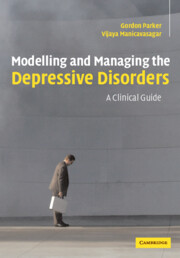Book contents
- Frontmatter
- Contents
- Acknowledgements
- Introduction
- Part I The current model for depressive disorders and its impact on clinical management
- Part II The diagnosis and management of melancholic and psychotic depression
- 4 Management of melancholic depression
- 5 Management of psychotic depression
- 6 Bipolar melancholic or psychotic depression
- Part III An introduction to non-melancholic depression
- Part IV Modelling and managing the non-melancholic depressive disorders
- Appendix 1 The DMI-18 and the DMI-10
- Appendix 2 The CORE system of measuring psychomotor disturbance
- Appendix 3 The temperament and personality measure
- References
- Index
6 - Bipolar melancholic or psychotic depression
from Part II - The diagnosis and management of melancholic and psychotic depression
Published online by Cambridge University Press: 17 August 2009
- Frontmatter
- Contents
- Acknowledgements
- Introduction
- Part I The current model for depressive disorders and its impact on clinical management
- Part II The diagnosis and management of melancholic and psychotic depression
- 4 Management of melancholic depression
- 5 Management of psychotic depression
- 6 Bipolar melancholic or psychotic depression
- Part III An introduction to non-melancholic depression
- Part IV Modelling and managing the non-melancholic depressive disorders
- Appendix 1 The DMI-18 and the DMI-10
- Appendix 2 The CORE system of measuring psychomotor disturbance
- Appendix 3 The temperament and personality measure
- References
- Index
Summary
While the recommendations given in Chapters 4 and 5 have been predicated on unipolar patterns, the management of those who have a bipolar lifetime course of melancholic or psychotic depression is much more complicated. As noted earlier, those with bipolar disorder are highly likely (approximately 80%) to have melancholic or psychotic depression patterns when depressed. More specifically, bipolar II patients tend to have melancholic depression, but not psychotic depression; while up to 50% of those with bipolar I disorder will experience psychotic depression. The distinctions between differing bipolar disorders make management even more complicated.
Firstly, distinctions between the disorders may not be dimensional (i. e. bipolar II being viewed as a ‘less severe’ disorder than bipolar I) as generally assumed. A recent review (Hadjipavlou et al. 2004) indicated that, while the ‘highs’ may not be distinctly disturbing in bipolar II disorder, both the course and the depressive episodes may be just as ‘severe’ for the I and II expressions, while those with bipolar II may have longer episodes and lengthier periods of sub-syndromal dysfunction, as well as be at greater risk of suicide.
Secondly, those authors concluded that basing treatment recommendations for those with bipolar II on bipolar I studies ‘may prove to be at the very least hasty and premature, if not inappropriate’.
- Type
- Chapter
- Information
- Modelling and Managing the Depressive DisordersA Clinical Guide, pp. 47 - 50Publisher: Cambridge University PressPrint publication year: 2005



